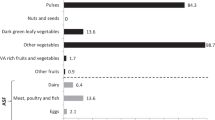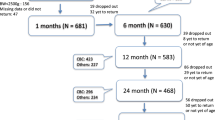Abstract
Background/Objectives:
Helicobacter pylori infection and iron and vitamin B12 deficiencies are widespread in economically disadvantaged populations. There is emerging evidence that H. pylori infection has a negative effect on the absorption of these micronutrients. The aim of this study was to evaluate the effect of H. pylori infection on the efficacy of micronutrient (including iron and vitamin B12)-fortified foods supplied for 1 year in marginally nourished children.
Subjects/Methods:
In all, 543 Indian children, aged 6–10 years, participated in a double-blind, randomized controlled intervention trial, receiving foods fortified with either high (100% Recommended Dietary Allowances (RDA)) or low (15% RDA) amounts of iron, vitamin B12 and other micronutrients. The presence of H. pylori infection was diagnosed by the 13C-labeled urea breath test at 11 months after the start of the intervention. Blood hemoglobin, serum ferritin (SF), total body iron and plasma vitamin B12 were estimated at baseline and 12 months, and differences between these time points were assessed using an independent t-test.
Results:
Overall, the prevalence of H. pylori infection in this group of children was 79%. Baseline hemoglobin, SF, body iron and vitamin B12 concentrations were not associated with H. pylori infection. The response to the intervention (either high or low amounts of iron and vitamin B12 fortification) in terms of change in iron markers and vitamin B12 status did not differ between children with and without H. pylori infection.
Conclusions:
This study shows that the presence of H. pylori infection did not affect the efficacy of long-term iron and vitamin B12 fortification in these marginally nourished children.
This is a preview of subscription content, access via your institution
Access options
Subscribe to this journal
Receive 12 print issues and online access
$259.00 per year
only $21.58 per issue
Buy this article
- Purchase on Springer Link
- Instant access to full article PDF
Prices may be subject to local taxes which are calculated during checkout
Similar content being viewed by others
References
Allen LH, Rosado JL, Casterline JE, López P, Muñoz E, Garcia OP et al. (2000). Lack of hemoglobin response to iron supplementation in anemic Mexican preschoolers with multiple micronutrient deficiencies. Am J Clin Nutr 71, 1485.
Bardhan PK (1997). Epidemiological features of Helicobacter pylori infection in developing countries. Clin Infect Dis 25, 973–978.
Burtis CA, Ashwood ER (1996). Fundamentals of Clinical Chemistry. WB Saunders Company: Philadelphia, PA.
Carnicer J, Badia R, Argemi J (1997). Helicobacter pylori gastritis and sideropenic refractory anemia. J Pediatr Gastroenterol Nutr 25, 441.
Collett JA, Burt MJ, Frampton CM, Yeo KH, Chapman TM, Buttimore RC et al. (1999). Seroprevalence of Helicobacter pylori in the adult population of Christchurch: risk factors and relationship to dyspeptic symptoms and iron studies. N Z Med J 112, 292–295.
Cook JD, Flowers CH, Skikne BS (2003). The quantitative assessment of body iron. Blood 101, 3359–3364.
Correa P (1992). Human gastric carcinogenesis: a multistep and multifactorial process--First American Cancer Society Award Lecture on Cancer Epidemiology and Prevention. Cancer Res 52, 6735–6740.
Dhaenens L, Szczebara F, Husson MO (1997). Identification, characterization, and immunogenicity of the lactoferrin-binding protein from Helicobacter pylori. Infect Immun 65, 514–518.
Dooley CP, Cohen H, Fitzgibbons PL, Bauer M, Appleman MD, Perez-Perez GI et al. (1989). Prevalence of Helicobacter pylori infection and histologic gastritis in asymptomatic persons. N Engl J Med 321, 1562–1566.
Dore SP, Krupadas S, Borgonha S, Kurpad AV (1997). The 13C urea breath test to assess Helicobacter pylori infection in school children. Natl Med J India 10, 57–60.
Dufour C, Brisigotti M, Fabretti G, Luxardo P, Mori PG, Barabino A (1993). Helicobacter pylori gastric infection and sideropenic refractory anemia. J Pediatr Gastroenterol Nutr 17, 225–227.
Gill HH, Majmudar P, Shankaran K, Desai HG (1994). Age-related prevalence of Helicobacter pylori antibodies in Indian subjects. Indian J Gastroenterol 13, 92–94.
Graham DY, Adam E, Reddy GT, Agarwal JP, Agarwal R, Evans Jr DJ et al. (1991). Seroepidemiology of Helicobacter pylori infection in India. Comparison of developing and developed countries. Dig Dis Sci 36, 1084–1088.
Hershko C, Ronson A (2009). Iron deficiency, Helicobacter infection and gastritis. Acta Haematol 122, 97–102.
IAEA (2000). Isotopic Techniques to Examine the Significance of Infection and Other Insults in Early Childhood to Diarrhoea Morbidity, Mal-Assimilation and Failure to Thrive. NAHRES, IAEA: Vienna, Austria.
Kaptan K, Beyan C, Ural AU, Cetin T, Avcu F, Gulsen M et al. (2000). Helicobacter pylori--is it a novel causative agent in vitamin B12 deficiency? Arch Intern Med 160, 1349–1353.
Kehrt R, Becker M, Brosicke H, Kruger N, Helge H (1997). Prevalence of Helicobacter pylori infection in Nicaraguan children with persistent diarrhea, diagnosed by the 13C-urea breath test. J Pediatr Gastroenterol Nutr 25, 84–88.
Klein PD, Graham DY, Gaillour A, Opekun AR, Smith EO (1991). Water source as risk factor for Helicobacter pylori infection in Peruvian children. Gastrointestinal Physiology Working Group. Lancet 337, 1503–1506.
Kuipers EJ, Israel DA, Kusters JG, Gerrits MM, Weel J, van Der Ende A et al. (2000). Quasispecies development of Helicobacter pylori observed in paired isolates obtained years apart from the same host. J Infect Dis 181, 273–282.
Lohman TG, Roche AF, Martorell R (eds) (1988). Anthropometric Standardization Reference Manual. Human Kinetics Publishers: Champaign, IL.
Mahalanabis D, Islam MA, Shaikh S, Chakrabarty M, Kurpad AV, Mukherjee S et al. (2005). Haematological response to iron supplementation is reduced in children with asymptomatic Helicobacter pylori infection. Br J Nutr 94, 969–975.
Marshall BJ, Warren JR (1984). Unidentified curved bacilli in the stomach of patients with gastritis and peptic ulceration. Lancet 1, 1311–1315.
Miale JB (1982). Laboratory Medicine: Hematology. CV Mosby: St Louis.
Milman N, Rosenstock S, Andersen L, Jorgensen T, Bonnevie O (1998). Serum ferritin, hemoglobin, and Helicobacter pylori infection: a seroepidemiologic survey comprising 2794 Danish adults. Gastroenterology 115, 268–274.
Muhsen K, Cohen D (2008). Helicobacter pylori infection and iron stores: a systematic review and meta-analysis. Helicobacter 13, 323–340.
Muthayya S, Eilander A, Transler C, Thomas T, van der Knaap HC, Srinivasan K et al. (2009). Effect of fortification with multiple micronutrients and n-3 fatty acids on growth and cognitive performance in Indian schoolchildren: the CHAMPION (Children's Health and Mental Performance Influenced by Optimal Nutrition) study. Am J Clin Nutr 89, 1766–1775.
Parsonnet J (1998). Helicobacter pylori. Infect Dis Clin North Am 12, 185–197.
Peach HG, Bath NE, Farish SJ (1998). Helicobacter pylori infection: an added stressor on iron status of women in the community. Med J Aust 169, 188–190.
Peek Jr RM, Blaser MJ (2002). Helicobacter pylori and gastrointestinal tract adenocarcinomas. Nat Rev Cancer 2, 28–37.
Peterson WL (1991). Helicobacter pylori and peptic ulcer disease. N Engl J Med 324, 1043–1048.
Sarker SA, Davidsson L, Mahmud H, Walczyk T, Hurrell RF, Gyr N et al. (2004). Helicobacter pylori infection, iron absorption, and gastric acid secretion in Bangladeshi children. Am J Clin Nutr 80, 149–153.
Sarker SA, Mahalanabis D, Hildebrand P, Rahaman MM, Bardhan PK, Fuchs G et al. (1997). Helicobacter pylori: prevalence, transmission, and serum pepsinogen II concentrations in children of a poor periurban community in Bangladesh. Clin Infect Dis 25, 990–995.
Seo JK, Ko JS, Choi KD (2002). Serum ferritin and Helicobacter pylori infection in children: a sero-epidemiologic study in Korea. J Gastroenterol Hepatol 17, 754–757.
Serin E, Gumurdulu Y, Ozer B, Kayaselcuk F, Yilmaz U, Kocak R (2002). Impact of Helicobacter pylori on the development of vitamin B12 deficiency in the absence of gastric atrophy. Helicobacter 7, 337–341.
Suerbaum S, Michetti P (2002). Helicobacter pylori infection. N Engl J Med 347, 1175–1186.
Sullivan PB, Thomas JE, Wight DG, Neale G, Eastham EJ, Corrah T et al. (1990). Helicobacter pylori in Gambian children with chronic diarrhoea and malnutrition. Arch Dis Child 65, 189–191.
Thankachan P, Muthayya S, Walczyk T, Kurpad AV, Hurrell RF (2007). An analysis of the etiology of anemia and iron deficiency in young women of low socioeconomic status in Bangalore, India. Food Nutr Bull 28, 328–336.
Thomas JE, Dale A, Bunn JE, Harding M, Coward WA, Cole TJ et al. (2004). Early Helicobacter pylori colonisation: the association with growth faltering in the Gambia. Arch Dis Child 89, 1149–1154.
Thomas JE, Dale A, Harding M, Coward WA, Cole TJ, Weaver LT (1999). Helicobacter pylori colonization in early life. Pediatr Res 45, 218–223.
Torres J, Perez-Perez G, Goodman KJ, Atherton JC, Gold BD, Harris PR et al. (2000). A comprehensive review of the natural history of Helicobacter pylori infection in children. Arch Med Res 31, 431–469.
Uemura N, Okamoto S, Yamamoto S, Matsumura N, Yamaguchi S, Yamakido M et al. (2001). Helicobacter pylori infection and the development of gastric cancer. N Engl J Med 345, 784–789.
WHO (1995). Expert Committee on Physical Status. Physical Status: The Use and Interpretation of Anthropometry. WHO Technical Report. World Health Organization: Geneva.
WHO/CDC (2004). Assessing the Iron Status of Populations. Report of a Joint Technical Consultation on the Assessment of Iron Status at the Population Level. World Health Organization: Geneva, Switzerland.
WHO/FAO (2004). Vitamin and Mineral Requirements in Human Nutrition 2nd edn. World Health Organization/Food and Agricultural Organization: Geneva.
Yokota S, Konno M, Mino E, Sato K, Takahashi M, Fujii N (2008). Enhanced Fe ion-uptake activity in Helicobacter pylori strains isolated from patients with iron-deficiency anemia. Clin Infect Dis 46, e31–e33.
Zhang ZW, Patchetta SE, Perrettb D, Katelarisa PH, Domizioc P, Farthinga MJG (1998). The relation between gastric vitamin C concentrations, mucosal histology, and CagA seropositivity in the human stomach. Gut 43, 322–326.
Zimmermann MB, Molinari L, Staubli-Asobayire F (2005). Serum transferrin receptor and zinc protoporphyrin as indicators of iron status in African children. Am J Clin Nutr 81, 615–623.
Acknowledgements
We are most grateful to the principals and teachers of the schools, the children and their parents for their participation in the study. We express our thanks to all our colleagues who were involved in data collection, biochemical and isotope analyses and product development and distribution, Vani Amalrajan, Leena Sebastian, Tony Raj, Shanthi Chellan, Binil Antony, Rangaswamy and Mari Venkatachari, and all the study staff from St John's Medical College and Research Institute, Bangalore, India, as well as Estelle Gaudier, Sue McKay and Regine van der Hee (all URDV) for initial discussions and critical reading of the paper This study was funded by Unilever Research and Development Vlaardingen B.V., The Netherlands, and St John's National Academy of Health Sciences, Bangalore, India.
Author information
Authors and Affiliations
Corresponding author
Ethics declarations
Competing interests
A Eilander, A Sierksma, GS Duchateau and LGJ Frenken were employees of Unilever during the time of the study. All other authors declare no conflict of interest.
Additional information
Contributors: PT, SM, AE, AS, GD, LF and AVK were involved in the conception, design and interpretation of the results of the study. PT and SM wrote the paper and were responsible for overall study management and data collection. TT carried out the statistical analyses. All authors have reviewed the paper and approved the final version.
Rights and permissions
About this article
Cite this article
Thankachan, P., Muthayya, S., Sierksma, A. et al. Helicobacter pylori infection does not influence the efficacy of iron and vitamin B12 fortification in marginally nourished Indian children. Eur J Clin Nutr 64, 1101–1107 (2010). https://doi.org/10.1038/ejcn.2010.126
Received:
Revised:
Accepted:
Published:
Issue Date:
DOI: https://doi.org/10.1038/ejcn.2010.126



